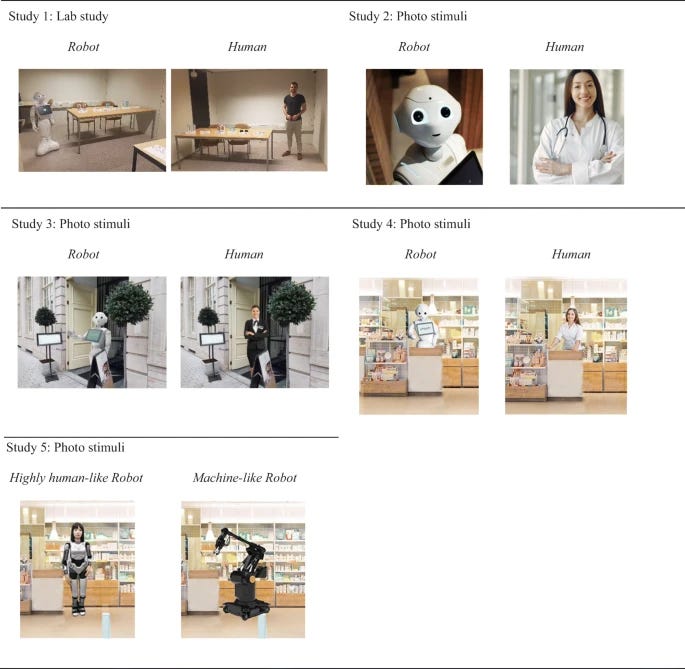The Intelligent Friend - The newsletter about the AI-humans relationships, based only on scientific papers.
Hello, dear readers! I was 'hosted' on the newsletter which gives voice to many Technical Writers,
by and many The Intelligent Friend welcomed new people. Plus, I've found that my little newsletter has generated nearly 250 signups for other writers, so I'm so glad! P.S. Here you can find the new issue of Intellibox (last one open to everyone!), where you can immerse yourself in the rainforest and get lots of ideas for your newsletter.Intro
One of my favorite topics: how robots can ease feelings that arise from uncomfortable situations. Do you think the cases are few, if not non-existent? Make yourselves comfortable, we'll talk about it today.
The paper in a nutshell
Title: Robots do not judge: service robots can alleviate embarrassment in service encounters. Authors: Holthöwer & van Doorn . Year: 2023. Journal: Journal of the Academy of Marketing Science.
Main result: being served by a robot, as opposed to a human, can reduce the fear of social judgment in specific situations. This is because the absence of human social presence in automated services eliminates the perception of being socially judged.
Starting from theories regarding embarrassment and social judgement, scholars investigate how, in certain types of services, interaction with robots can reduce the unpleasant sensations experienced by consumers.
'I'd rather not be there'
Imagine being in line at the pharmacy. You're a little nervous. Wait patiently for your turn. So, when he arrives, you approach the pharmacist, and whisper as if he were sharing a gossip. You think you're alone but...just when it's your turn, quite a few people arrive at the pharmacy and get in line. You have to buy a drug or something else particularly embarrassing. And you do everything not to make people understand what. Who hasn't happened to this?
This type of situation is certainly an embarrassing situation, in which we feel, or perceive a so-called 'social judgement', that is, a judgment on what we do by other people. Social judgment arises due, as can be imagined, to a social presence: we feel that there are other people who judge what we do, and therefore we feel embarrassed.
Many scientific studies have shown that 'human' social presence (and you will see shortly why this is specific) strongly influences consumer behavior1. And it does so to the point of choosing not to purchase or to buy as quickly as possible234, as in the case of medication to treat a sexually transmitted disease (STD)5, condoms6 or other.
As you can imagine, these situations are particularly relevant in the healthcare sector, but it does not only concern this type of product. For example, a 2009 study demonstrated that, in general, being in contact with service providers that are 'embarrassing' for the consumer can lead the consumer to avoid that encounter in the future7.
Furthermore, previous research has demonstrated that specific frontline employee behaviors, such as criticizing a customer, can threaten a customer's social identity8. These behaviors can have a serious impact on the consumer: science tells us that there are possibilities that consumers may engage in behaviors that risk their health, such as avoiding medical care despite significant health issues910.
Now, think about the things you did when you found yourself in these situations. I ask this because, as I often repeat, I am sometimes fascinated by how science frames and highlights human behaviors which for us are something totally incorporated into our daily lives, identifying their causes, forms and effects. According to research, in fact, in situations in which we are afraid of social judgment - therefore which cause us embarrassment - we implement these behaviors:
Visiting less-crowded stores, avoid asking employees for help, and wait for other customers to leave the aisle11);
Shopping online for items such as dieting products;
Opting for self-service checkout systems for purchases like condoms12.
However, these solutions do not resolve all possible side effects. Online purchases, for instance, can be object of technological or time issues such as the product not13. Additionally, self-service technologies and online retailers may raise legal, ethical, and safety concerns, such as when purchasing medications14. And although some behaviors may constitute possible solutions in some cases, they do not remove the possibilities of interactional unexpected situations.
Good thing you're here, robot!
We talked about embarrassment, social judgement, social presence, products and situations that make us uncomfortable. But what does this have to do with Artificial Intelligence or technology?
Small interlude: for this issue, as you can see, I tried to use a reverse approach, starting from the extremes and arriving at the center, compared to how I usually do. I was inspired by a note from about this, thanks for the idea! Let me know what you think in the comments.
Now let's get back to us. Robots can play a very important role in reducing the discomfort we feel in embarrassing situations, having enormous repercussions:
for us and our health;
for companies and service providers;
for social interactions.
In fact, some previous research, despite negative perceptions in certain situations, indicates that after a service failure, consumers may evaluate a service robot more favorably than a frontline human service employee15.
One thing I found absolutely interesting: research has shown that preference for a robot over a human can depend on the task. Older adults, for example, preferred robotic assistance for tasks like housekeeping and medication reminders but not for personal tasks like shaving, walking, or dressing16.
Researchers viewed socially assistive robots as beneficial in co-creating service value (e.g., as an extended self, an enabler, and an ally) but also saw potential drawbacks (e.g., as a deactivator, a replacement, and an intruder)17.
Another important factor to take into account, and which we have often talked about, is the design of the robot: it can be tailored to fit the service context and meet consumer expectations, but we must consider that design influences our perceptions of anthropomorphism and therefore can make us more or less well prepared to interact with the machine. As we have seen in other issues, human-like robots can increase customer trust, intention to use, and enjoyment18.
However, the evidence in support of an 'omni-benefit' of robots in interactions with consumers is absolutely conflicting. If on the one hand robots favor positive interactions, sensations and perceptions, on the other hand anthropomorphism can have collateral effects that are anything but positive: robot features like autonomy have been studied, revealing that perceived autonomy can reduce customers' feelings of control and responsibility for outcomes19. So, in this specific case of embarrassing situations, will robots have a positive or negative result on consumers' feelings?
I will buy from you
To test their hypotheses, the scholars followed a very rigid methodology structured in 5 studies, aimed at measuring, among other things: whether consumers preferred purchasing embarrassing products from a robot or a human provider; if they were willing to click more on a Facebook campaign that featured a robot than a human; whether consumers felt more judged by a robot or a human; the role of robot anthropomorphism.
The results really intrigued me and I intend to delve further into the topic in future issues:
When social presence is automated by a service robot, anxiety about social judgment decreases, helping consumers overcome reluctance to engage in embarrassing situations;
Consumers are more likely to acquire embarrassing products or accept alternative offerings from the same service provider when interacting with robots;
Highly human-like robots can make consumers feel more socially judged, similar to interactions with human service providers.
This study, in my opinion, is not only important for suppliers of 'embarrassing' services and products in the reflection on the implementation of machines or robots in some phases of the purchase, but, in general, for the brands that produce the products mentioned , who can promote a more open and less embarrassing culture, and also discuss with their partners, given the relevance also for consumers' future choices and often for their health, how to create more comfortable environments and experiences for buyers.
Before moving on to the research questions, I remind you that you can subscribe to Nucleus, the exclusive weekly section in which I send 4 paper summaries, links to resources and interesting readings, and interview the authors. It comes out every Wednesday.
In this (open to everyone), for example, we talked about the political opinions of ChatGPT, a new environment for human-robot interactions and interesting links such as the similarity between “the child you” and the “current you”.
Just this? No: you receive also Intellibox, the weekly format in which you can immerse yourself in intriguing simulations via AI and at the same time get insights from a further paper that I found particularly interesting. Finally, you also you have access to exclusive threads in our chat, Society. Subscribe now.
Take-aways
You are looking at me? 'Human' social presence strongly influences consumer behavior and this particularly impacts products considered embarrassing.
Good thing it's a robot! When social presence is automated by a service robot, anxiety about social judgment decreases, helping consumers overcome reluctance to engage in embarrassing situations;
More like, more pressure. Highly human-like robots can make consumers feel more socially judged, similar to interactions with human service providers.
Further research directions
How does actual purchasing behavior, measured through cost per acquisition (CPA), compare when customers are served by robots versus human service providers?
How does the physical environment, where a social entity is present but not involved with the customer, influence the service experience and satisfaction?
Do the observed effects of reduced social judgment and increased customer comfort persist over multiple service encounters with a frontline service robot, beyond the initial customer-robot interaction?
Thank you for reading this issue of The Intelligent Friend and/or for subscribing. The relationships between humans and AI are a crucial topic and I am glad to be able to talk about it having you as a reader.
Has a friend of yours sent you this newsletter or are you not subscribed yet? You can subscribe here.
Surprise someone who deserves a gift or who you think would be interested in this newsletter. Share this post to your friend or colleague.
P.S. If you haven't already done so, in this questionnaire you can tell me a little about yourself and the wonderful things you do!
Argo, J. J., Dahl, D. W., & Manchanda, R. V. (2005). The influence of a mere social presence in a retail context. Journal of Consumer Research, 32(2), 207–212.
Grace, D. (2009). An examination of consumer embarrassment and repatronage intentions in the context of emotional service encounters. Journal of Retailing and Consumer Services, 16(1), 1–9.
Jones, C. L. E., Barney, C., & Farmer, A. (2018). Appreciating anonymity: An exploration of embarrassing products and the power of blending in. Journal of Retailing, 94(2), 186–202.
Krishna, A., Herd, K. B., & Aydınoğlu, N. Z. (2015). Wetting the bed at twenty-one: Embarrassment as a private emotion. Journal of Consumer Psychology, 25(3), 473–486.
Krishna, A., Herd, K. B., & Aydınoğlu, N. Z. (2019). A review of consumer embarrassment as a public and private emotion. Journal of Consumer Psychology, 29(3), 492–516.
Dahl, D. W., Manchanda, R. V., & Argo, J. J. (2001). Embarrassment in consumer purchase: The roles of social presence and purchase familiarity. Journal of Consumer Research, 28(3), 473–481.
Grace, D. (2009). An examination of consumer embarrassment and repatronage intentions in the context of emotional service encounters. Journal of Retailing and Consumer Services, 16(1), 1–9.
Habel, J., Alavi, S., & Pick, D. (2017). When serving customers includes correcting them: Understanding the ambivalent effects of enforcing service rules. International Journal of Research in Marketing, 34(4), 919–941.
Helweg-Larsen, M., & Collins, B. E. (1994). The UCLA multidimensional condom attitudes scale: Documenting the complex determinants of condom use in college students. Health Psychology, 13(3), 224–237.
Kiefe, C. I., Funkhouser, E., Fouad, M. N., & May, D. S. (1998). Chronic disease as a barrier to breast and cervical cancer screening. Journal of General Internal Medicine, 13(6), 357–365.
Blair, S., & Roese, N. J. (2013). Balancing the basket: The role of shopping basket composition in embarrassment. Journal of Consumer Research, 40(4), 676–691.
Jackson, T. W., Parboteeah, P., & Metcalfe-Poulton, S. (2014). The effects of consumer personality types on the attitudes and usage of self-checkout Technology in the Retail Sector among 18-22 years old. International Journal of Marketing Studies, 6(2), 15–30.
Miyazaki, A. D., & Fernandez, A. (2001). Consumer perceptions of privacy and security risks for online shopping. Journal of Consumer Affairs, 35(1), 27–44.
Fung, C. H., Woo, H. E., & Asch, S. M. (2004). Controversies and legal issues of prescribing and dispensing medications using the internet. Mayo Clinic Proceedings, 79(2), 188–194.
Merkle, M. (2019). Customer responses to service robots–comparing human-robot interaction with human-human interaction. In In proceedings of the 52nd Hawaii international conference on system sciences (pp. 8–11).
Smarr, C. A., Prakash, A., Beer, J. M., Mitzner, T. L., Kemp, C. C., & Rogers, W. A. (2012). Older adults’ preferences for and acceptance of robot assistance for everyday living tasks. Proceedings of the Human Factors and Ergonomics Society Annual Meeting, 56(1), 153–157.
Čaić, M., Odekerken-Schröder, G., & Mahr, D. (2018). Service robots: Value co-creation and co-destruction in elderly care networks. Journal of Service Management, 29(2), 178–205.
Van Pinxteren, M. M. E., Wetzels, R. W. H., Rüger, J., Pluymaekers, M., & Wetzels, M. (2019). Trust in humanoid robots: Implications for services marketing. Journal of Services Marketing, 33(4), 507–518.
Jörling, M., Böhm, R., & Paluch, S. (2019). Service robots: Drivers of perceived responsibility for service outcomes. Journal of Service Research, 22(4), 404–420.









Well executed. Beautiful formatting!!!